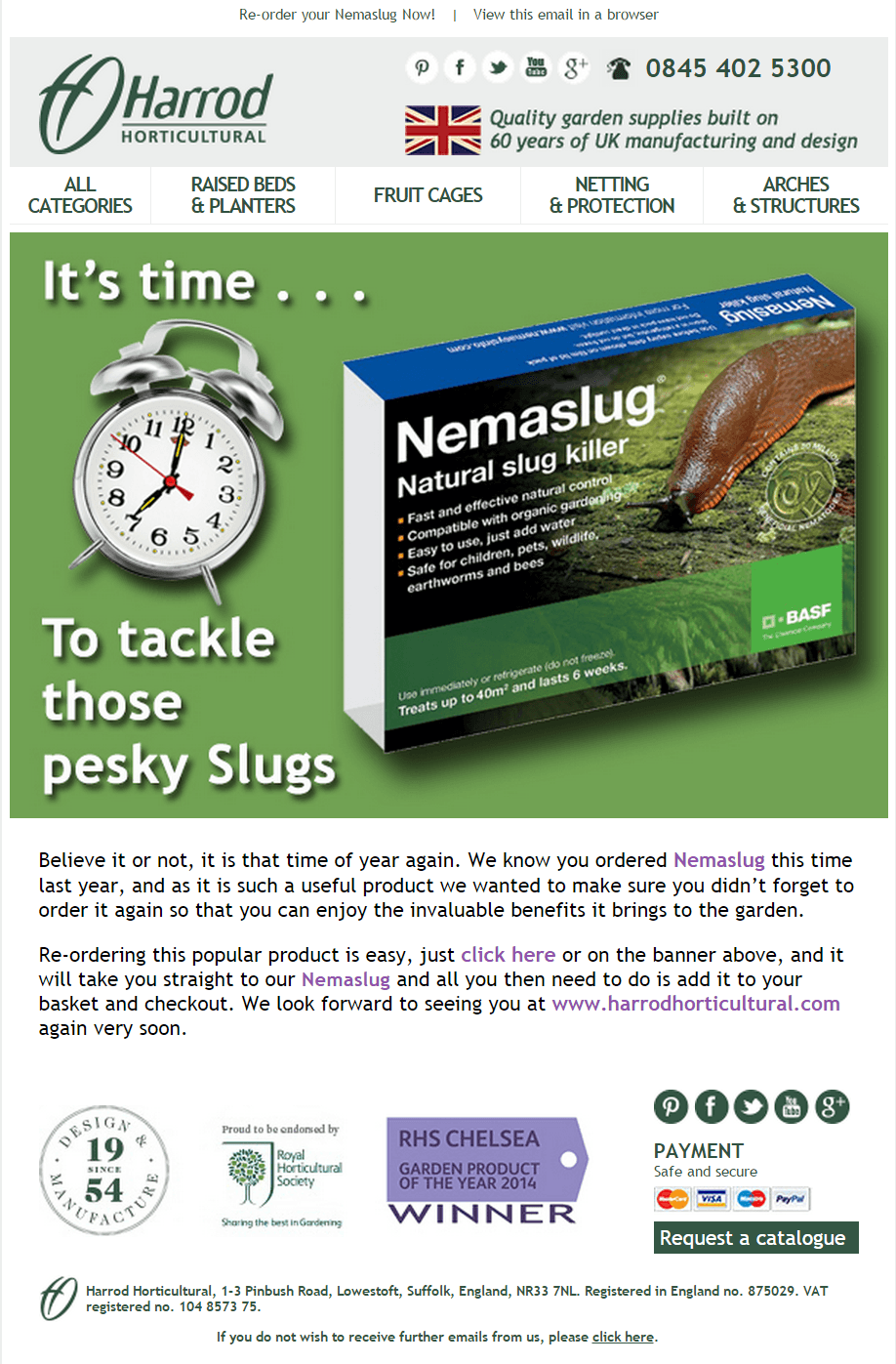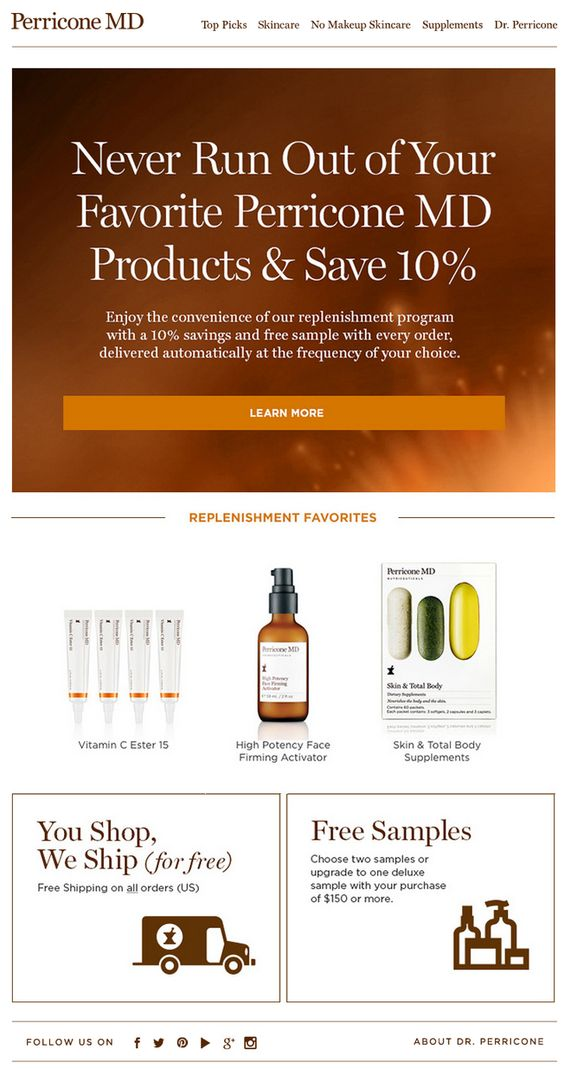List of the best ecommerce replenishment email templates.
In today’s fast-paced eCommerce industry, it can be hard to keep up with the latest trends. But one trend that’s here to stay is eCommerce replenishment emails.
Your customers are busy and overwhelmed, so they’re looking for ways to simplify their lives—and you can help them do that by making it easy to get the products they need without having to think about it.
Ecommerce replenishment emails are a great way to remind your customers that they need to restock their favorite products. Ecommerce replenishment emails are a crucial part of the customer experience because they help you build loyalty and keep your customers coming back for more. You can use them to promote new products, restock old products, or even offer incentives for customers who buy multiple items at a time.
If you’re an online retailer, replenishment emails are essential for keeping your customers satisfied. Here’s why:
They make sure that your customer’s needs are met in a timely manner.
They help assure your customers that they’re valued and appreciated by your business.
They increase customer loyalty and repeat purchases because they foster trust between you and them.
This is an essential tool for companies that rely on repeat customers because it encourages them to make another purchase and keep coming back. Without this kind of email, you’re essentially leaving money on the table.
But if you’re still not sure how to approach them, we’ve got you covered! We put together 30 templates and examples of eCommerce replenishment emails that are sure to inspire you and get your creative juices flowing.
Also read: Which ecommerce industries benefit the most from replenishment emails
Ecommerce Replenishment Email Templates and Examples
1. Amazon
If you’ve been a frequent Amazon customer, you’ve probably seen a few of their emails that suggest you’re running low on supplies.
You might think this is just a marketing ploy to convince you to buy more stuff. But it turns out that these emails are actually super useful for Amazon—and for you.
The first thing to know is that the emails are based on general shopper data, not on your personal purchase history. So if someone else has bought something in the past, but you haven’t bought it recently, the email will still go out to you. The second thing is that when they send one of these emails, they’ll typically include other products that customers who bought the item also bought repeatedly—so if you have one of those other items in your cart and decide to purchase it right now, Amazon will know that’s what triggered the email being sent out.
In other words: The email isn’t meant to make you spend more money; instead, it’s designed to help you spend less money by reminding you when something needs replacing or replenishing!
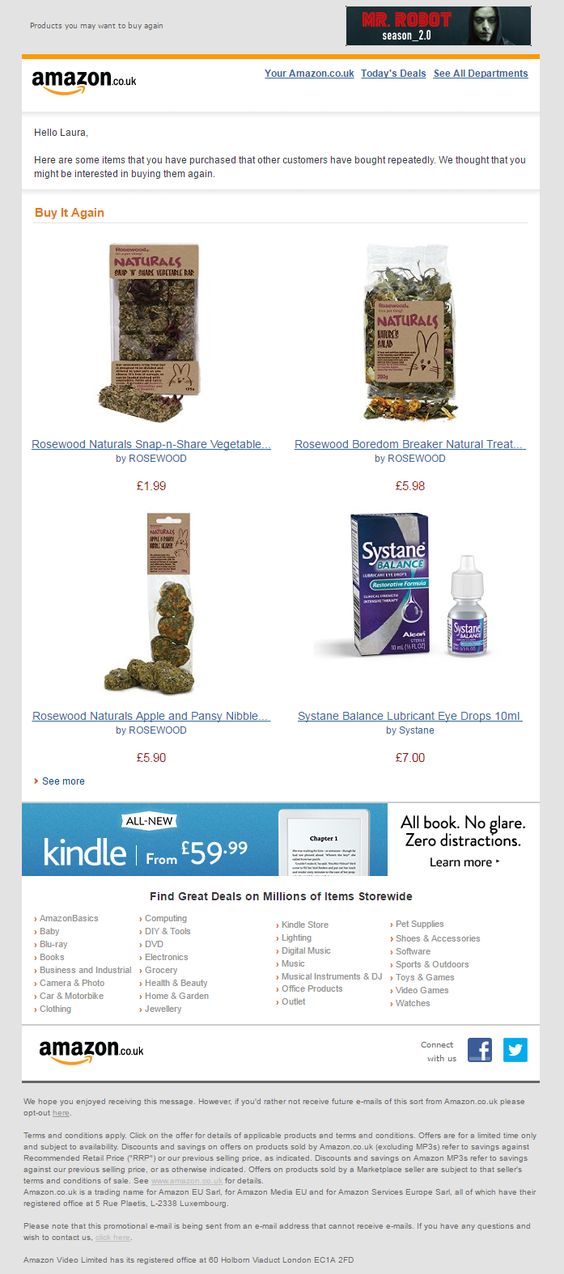
2. Clinique
Clinique’s email is a great example of a company that knows exactly who its customers are and what they want, even if they don’t know it themselves!
The email reminds customers to reorder their shaving cream, but it does so in an entirely non-pushy way. Instead of just telling you to reorder, they say “He knows you’ve been using his shaving cream.”
This email is so well-written because Clinique understands that people don’t want to feel like they’re being sold something—they want to feel like they’re already buying it and just need one more little push from their favorite brand.
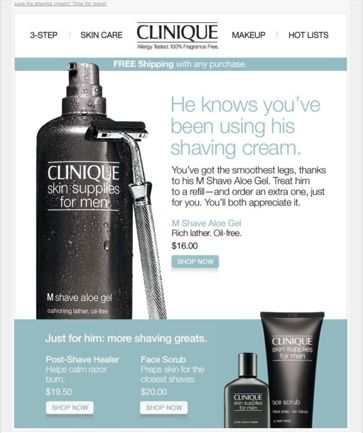
3. Rockin’ Wellness
Rockin’ Wellness has made it easy to continue your healthy lifestyle with their replenishment email.
The brand’s replenishment emails are quick and easy to reorder from your smartphone. It uses clear calls-to-action, big images, and buttons as well as one-click ordering. Since most people are going to receive and read these emails on the go, the brand makes sure it talks to the point.
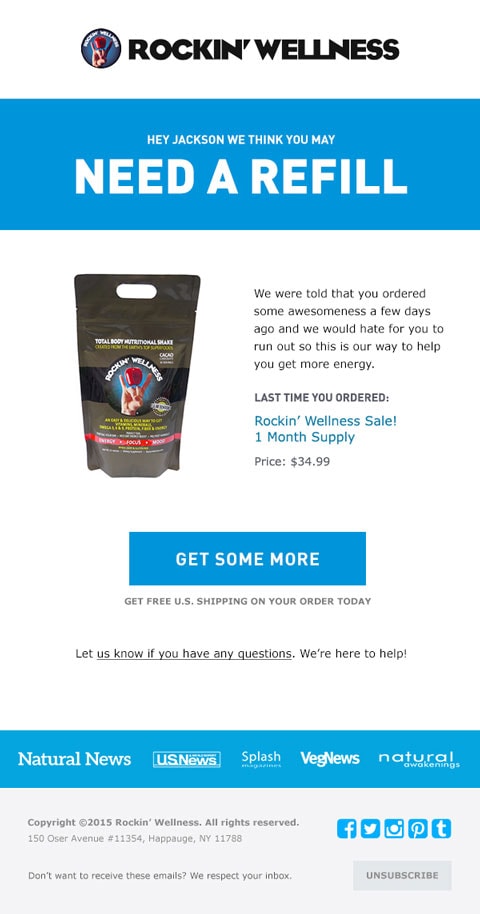
4. Grazeshop
Grazeshop’s email marketing strategy is a great example of how to create a visually-appealing, relevant email that drives consumer engagement.
The email provides the consumer with two options: they can either try another snack or reorder their product. Both of these options provide consumers with value and help build brand loyalty.
The email also features a picture of the product that was purchased previously. This helps give the consumer an idea of what they will be receiving and serves as an additional layer of relevancy.
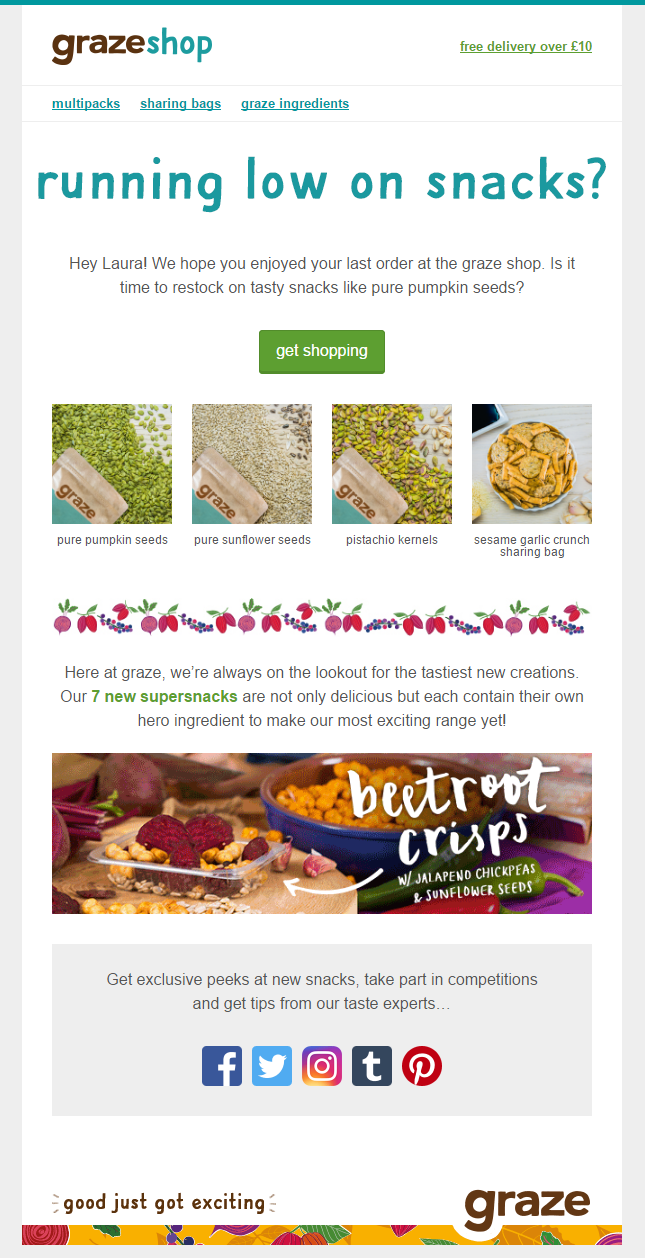
5. Lancome
Lancome’s replenishment email is a great example of using imagery to create a sense of urgency. The email is full of imagery of the face and the product, which makes you feel like you’re about to run out of the foundation. It also features an easy shop now button, so if you do need more foundation, it’s easy to get it. An auto-replenishment is not only useful for the customer but also is a guaranteed revenue stream for the business.
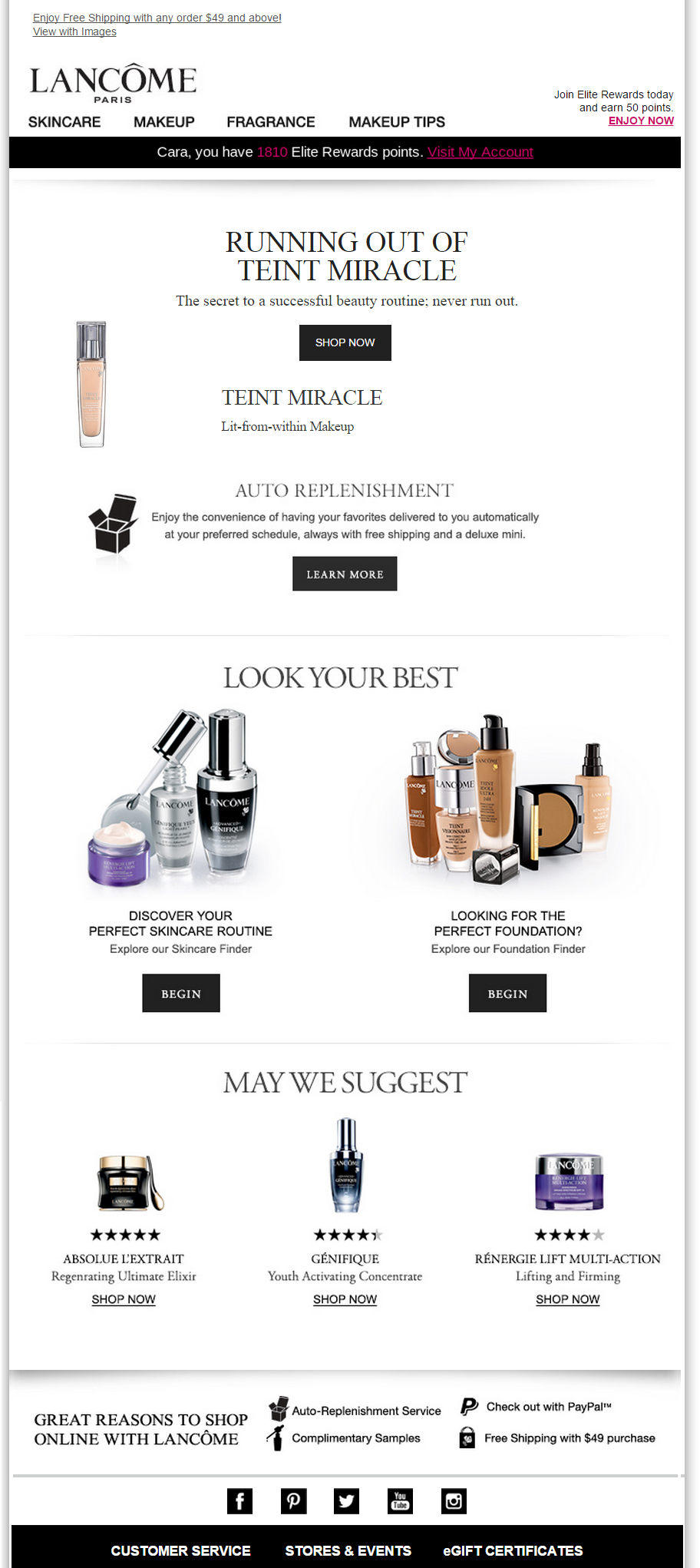
6. Drugstore.com
Drugstore.com knows that the best way to get you to buy more of their products is to make sure you don’t run out of your favorite ones. That’s why they send out this email, which reminds me to top up my stock of limited-stock products before it’s too late.
It’s also a great example of how to group products together on a single replenishment email!

7. Ernio Laszlo
Ernio Lazlo’s replenishment email has a very clear, straightforward tone. The email lists the products you may need to reorder along with mentioning free shipping benefits and other rewards.
The brand is big on the whole personalization thing due to which their email marketing campaign is designed to be as relevant and helpful as they can be. In addition to listing out the products that the customer might want to reorder, they also introduce an easy way to get personalized product recommendations by taking a small skin test.
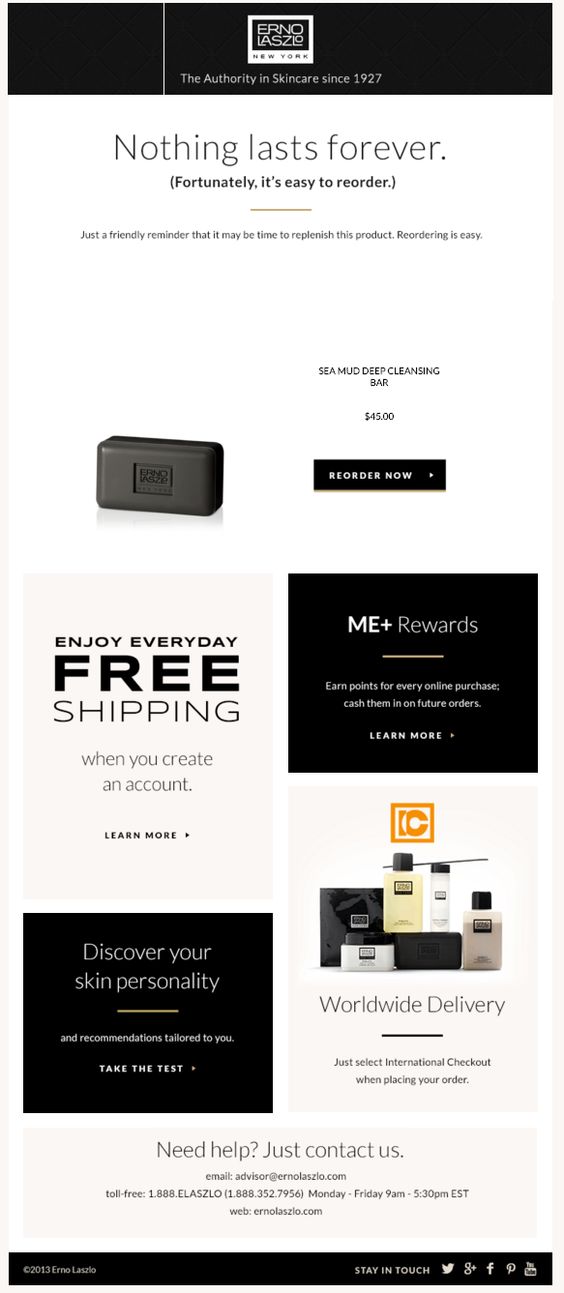
8. Just Right
Just Right’s email is a great example of how to get customers to reorder. The message reads like a personal note from the brand, asking the customer “Is Lucy’s bag almost empty?”
By letting the customer know that they may have only “10 days worth of stock left” and that it is ” time to place their next order”, the brand stresses on replenishing the personalized food blend asap. This instills a sense of urgency in the reader, who might have only a few days worth of stock left and doesn’t want to wait till its all finished.
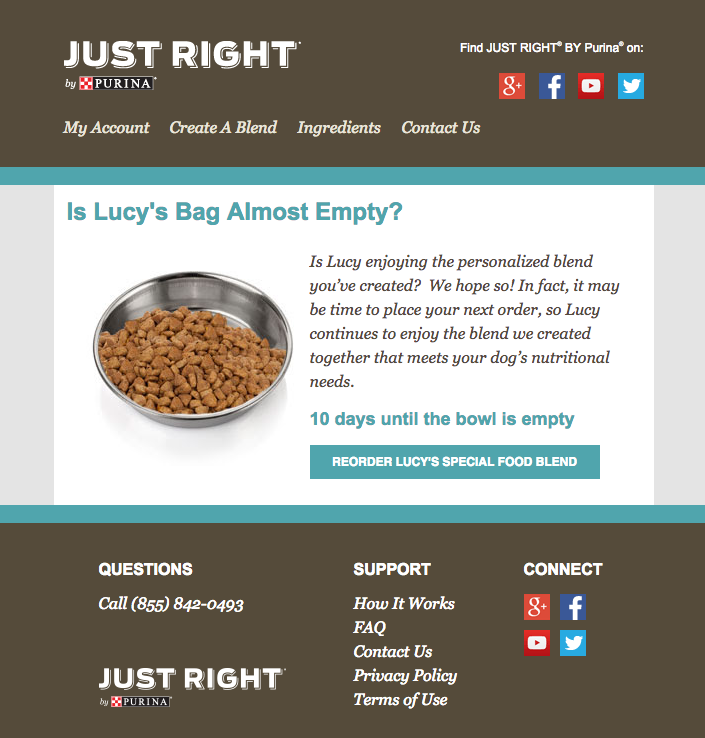
9. Belk
Belk’s uses a sure-shot strategy of mentioning a product’s advantages in its replenishment email, convincing the customer why they need to reorder. The brand uses the second half of the email to upsell/cross-sell by recommending more products.
The email begins by informing customers that they are low on a particular product and mentions how the product is extremely effective in what it does. This information, combined with an incentive to order before the price increases, encourages customers to reorder.
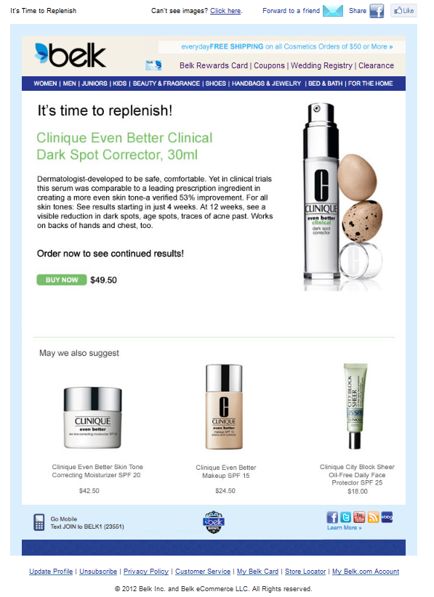
10. The Wod Life
The Wod Life’s replenishment email simply mentions that the customer might be running out of essential supplies and prompts them to reorder their favorite stuff.
It also goes ahead to help by recommending some products based on their past purchase history, which is a great way to increase conversions.
11. Sephora
Sephora’s replenishment email is a masterclass in CTA optimization.
It uses a big, bold CTA that doesn’t just call for action—it calls for action immediately. “Restock your stash” is the perfect way to remind customers of their favorites and encourage them to buy more, while also recommending similar products that they might like.

12. Harrod Horticulture
One of the most powerful ways to increase sales is to remind customers that they need to repurchase a product.
Harrod Horticultural created a replenishment campaign for its Nemaslug natural slug killer.
While it may not be selling a typical consumable product, but customers who bought it in the spring would likely want and need to buy it again the following year.
As a result, this replenishment campaign saw a 45% open rate, a 47% click-to-sale rate, and generated a 50% increase in sales year-over-year for that particular product. Not bad for a single email sent a year later.
13. Dollar Shave Club
One Dollar Shave Club is a great example of how to use re-engagement emails as sales tools. The brand knows how to sell. They use crisp, effective copy to tempt their customers into buying more of the product.
Their replenishment emails are sent to customers who have ordered from the site at least once before, and they typically include recommended products. The brand’s goal is to give customers a reason to check out new products, and it does this by including an image of a product and a link to the product page.
Even when it comes to a small purchase like razors, Dollar Shave Club uses this tactic. In one of their emails, they write: “You’ll be missing out on keeping your face fantastic if you don’t buy [product name] today.”
This is a great example of how we can use effective language to persuade our customers into buying from us. By using phrases like “keeping your face fantastic” and “missing out”, Dollar Shave Club creates an emotional connection between their products and the customer that makes them want to buy more.
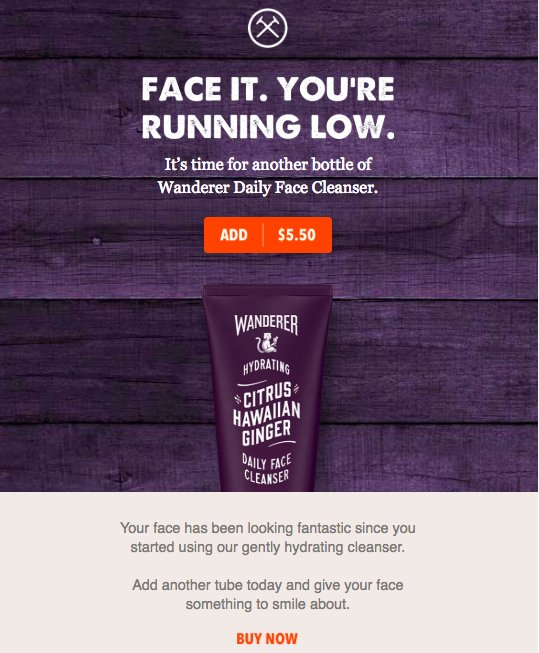
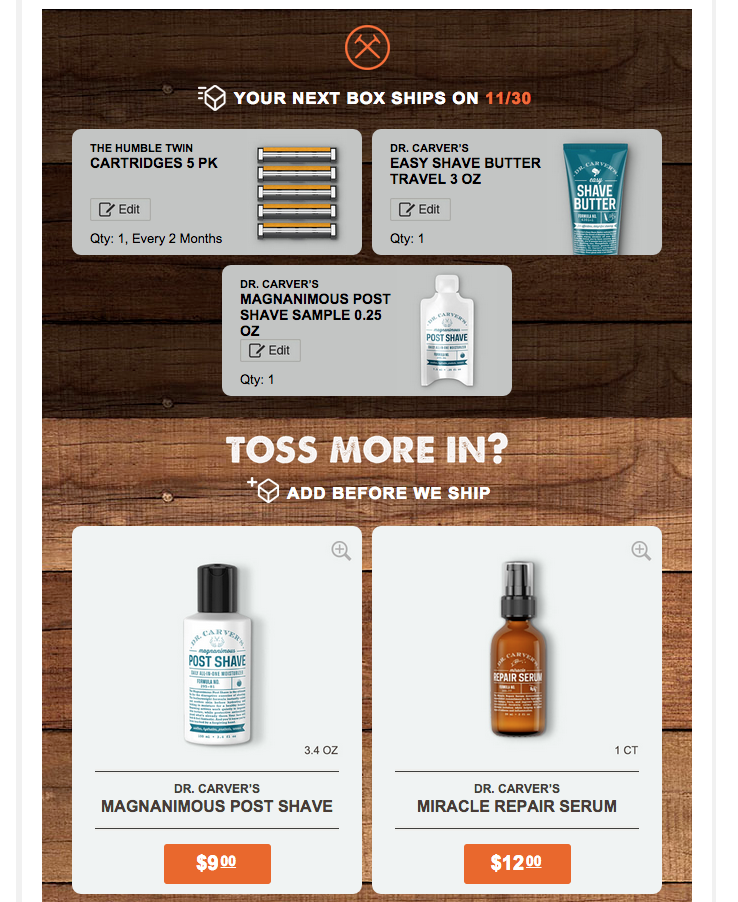
14. Dr. Perricone
Dr. Perricone’s has been a leader in the skincare industry for decades, and they know that you need to replace your skincare products on a regular basis. That’s why they send a replenishment email to their customers like you, offering a discount on your favorite products and free samples of other products to try out.
15. The Body Shop
The Body Shop’s email features its bestselling products to help customers restock their favorite products. The brand personalizes this email by mentioning the customer’s loyalty points and prompting them to use them.
In addition, the email makes sure to remind customers of their in-store facilities so that they can take advantage of their discounts and offers.
Furthermore, this email also includes a coupon code that can be used at checkout to get a discount on your next purchase.

16. Nike
Nike is a brand that knows how to get its customers back.
When you buy running shoes from Nike and wear them for a while, you notice that they start to get worn out. You can’t keep running in them anymore, so what do you do?
Nike has your back. They send you an email letting you know that they’ve got a new pair of running shoes in your size and will send it right to your door—for free! And they don’t just stop there: they also show off a few options so you can pick the one that suits your taste best.
It’s like having a personal shopper who knows exactly what you want.
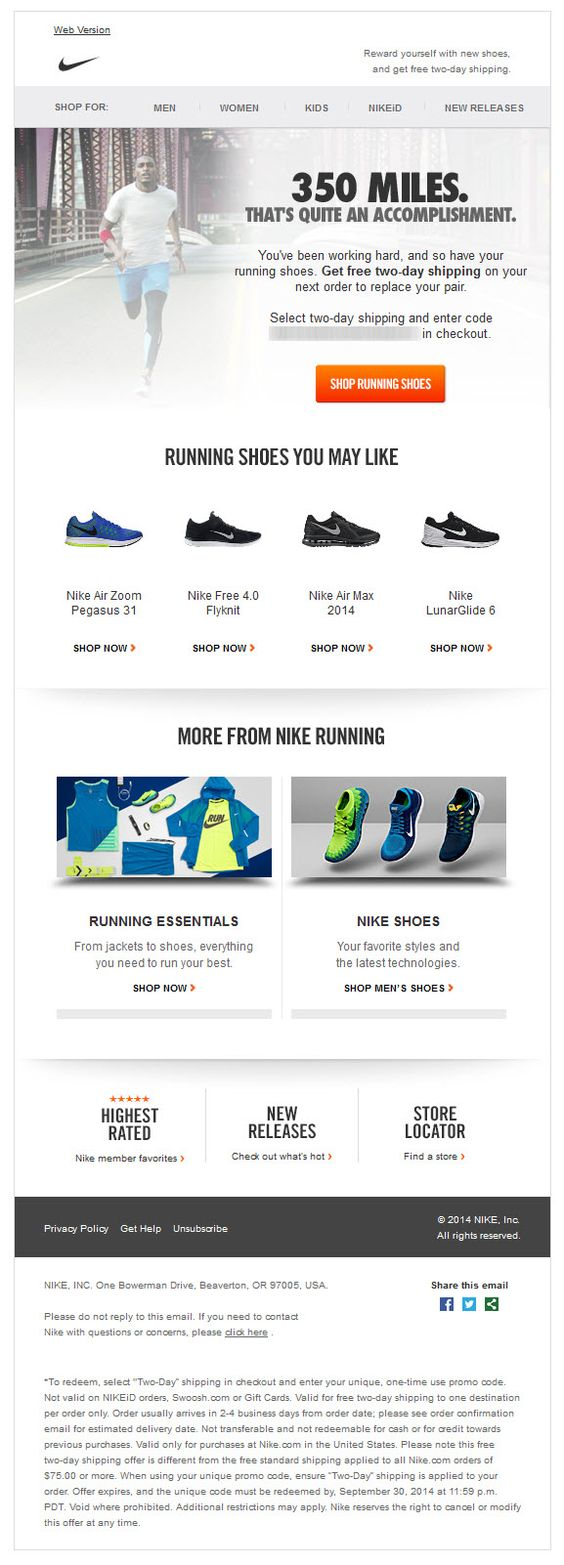
17. Chemist Warehouse
Chemist Warehouse’s email marketing campaign is a great example of how to engage customers by using their past purchasing history to make suggestions for future purchases.
Chemist Warehouse delivers replenishment emails to prompt customers to re-order products. The online pharmacy engages subscribers using past purchasing history to deliver dynamic email content that includes text and images of the product purchased along with other product suggestions and current pricing. Moreover, the call-to-action button leads customers to a pre-stocked shopping cart.
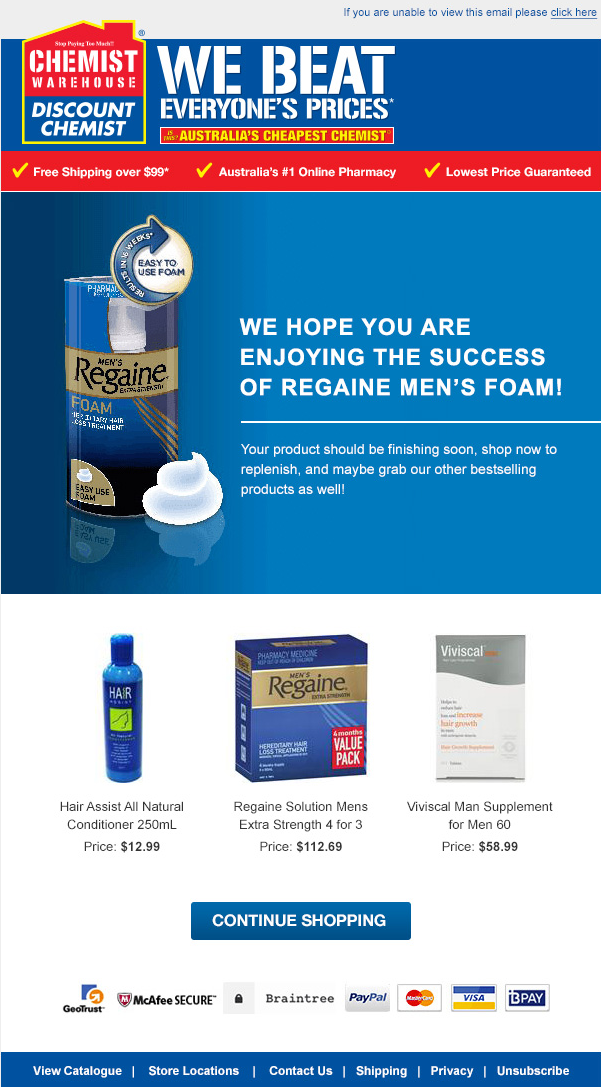
18. Feel Good Contacts
Feel Good Contacts sends out a replenishment email to remind you that your contacts are almost out and prompt their customers to sign up for the auto-replenish program and reorder contact lenses without visiting the website again and again.
This way, Feel Good Contacts can help ensure repeat purchases by making it easy for customers to reorder their favorite brand of contact lenses on autopilot—and this means more money in the bank for them!
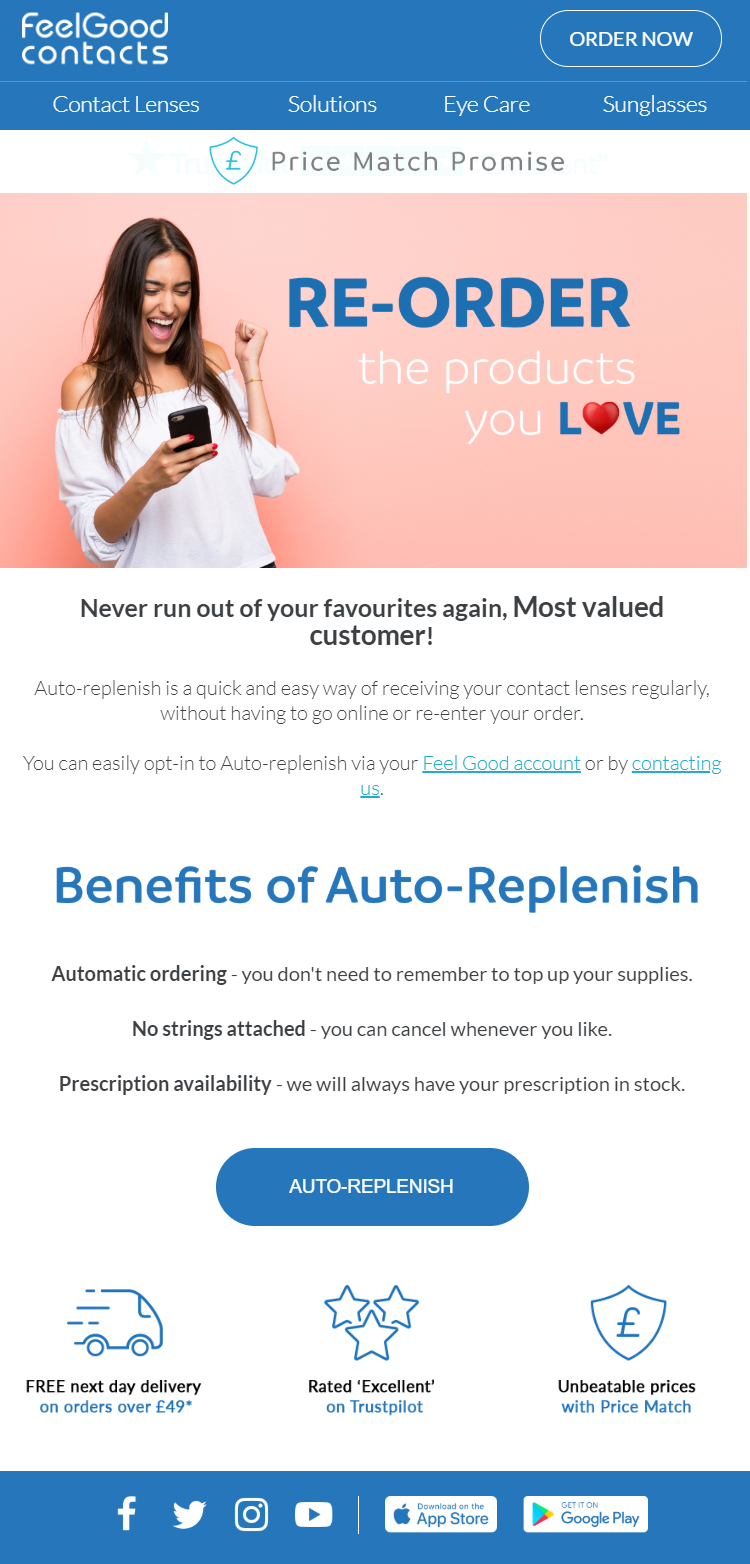
19. Viovet
Customers have busy lives and may forget about their pet’s health needs. Viovet sends replenishment emails to customers of particular products, reminding them that the time to reorder is approaching. By sending these reminders, Viovet reminds customers to order more food for their pet in advance so they don’t run out at an inconvenient time. This helps customers feel more prepared and less stressed when it comes time to order more food or other supplies for their pets.
These helpful reminders foster customer loyalty and increase the likelihood of repeat purchases. The reminders also encourage repeat purchases by reminding customers how much they love Viovet’s products!
20. Warby Parker
Warby Parker’s replenishment email features a clean, minimalistic layout. Simple and straightforward, this replenishment email enables the brand to show a customer that it has done its homework and figured out when his or her prescription is due to expire, making a returning customer feel wanted.
The brand also gives customers the option to choose their frames from its online store. This is an excellent move because it establishes Warby Parker as an expert in eyeglasses and allows customers to feel confident in their selection of frames.
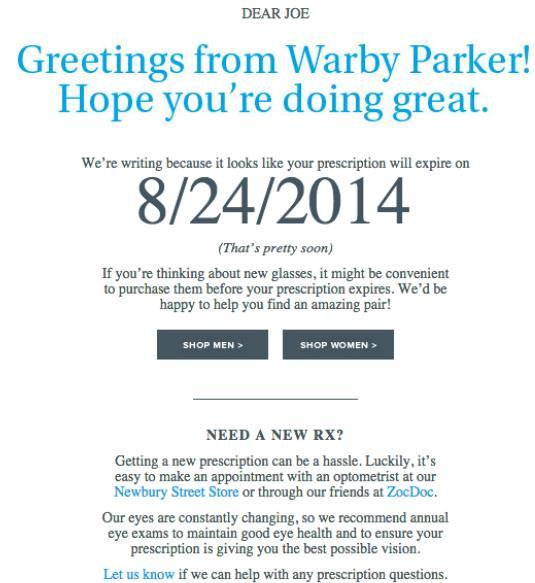
21. Man’s Best Friend
Man’s Best friend’s replenishment email is the perfect example of behavioral email marketing. When a customer buys dog food, the brand takes note of how much they bought and when they bought it. They use this info to send them an email reminder when it’s time to order again.

22. Etsy
Etsy’s replenishment email relies on great product imagery and minimal copy to get its customer to reorder their favorite products.
The email’s design is simple, but the use of color helps to draw the eye to the product images. The text is also clear, easy to read, and concise. The use of a call-to-action button makes it clear that customers should click on it if they want more of this product.
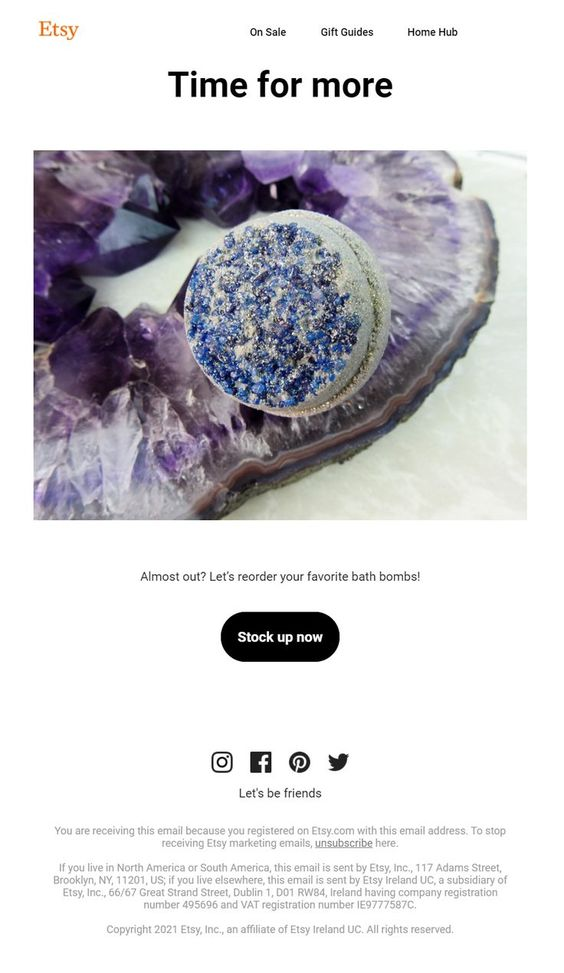
23. PlasticPlace
Sometimes plain and simple works the best. PlasticPlace knows that people quickly run out of trash bags. And therefore the replenishment email simply highlights the reader’s attention on the words “Running low” alongside the image of a trash bag.
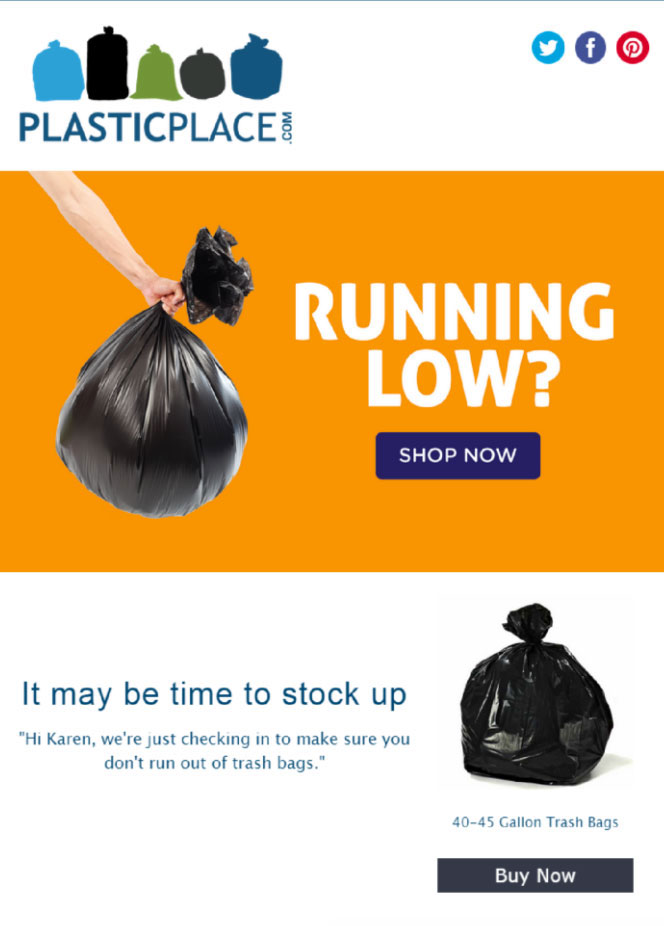
24. Harry’s
Harry’s has been known for its subscription service, where razor blades and other grooming essentials are automatically delivered on an ongoing basis. However, many customers opt-out of the subscription and, instead, restock their blades manually. The brand sends a series of “blades replenishment” emails after a few months of purchase, in one-week intervals, reminding them to restock before they run out.
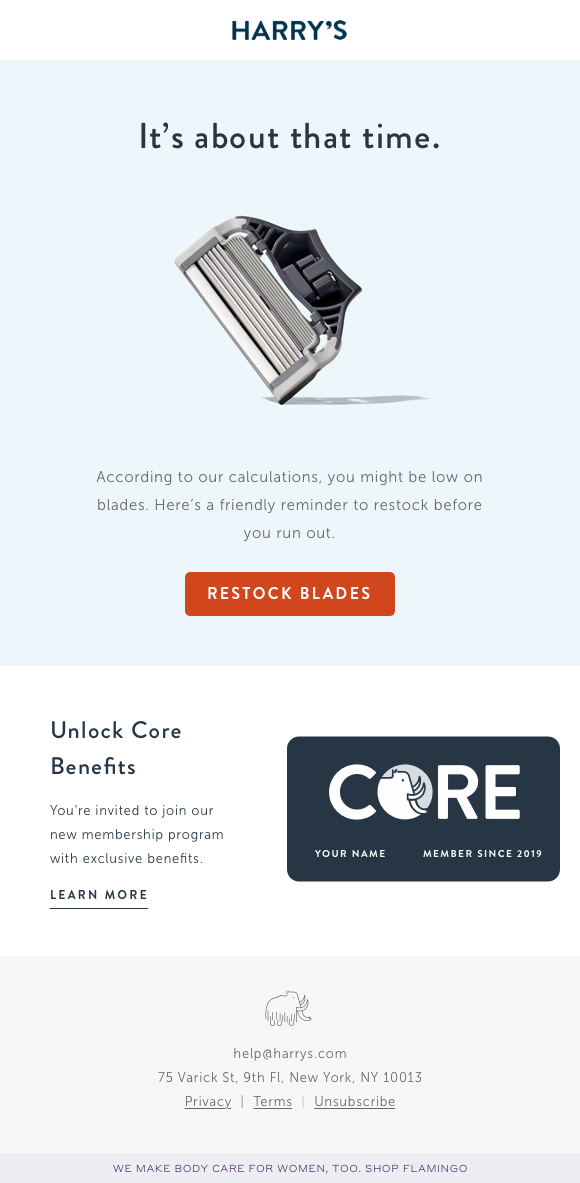
25. ILIA Beauty
A little goes a long way with ILIA Beauty’s replenishment email.
The company sends a short and sweet email with a distinct CTA that clearly outlines the next step for customers who have just about run out of their favorite product. The highlight of the email is the GIF featuring the foundation, and the adjoining copy informs the customer it’s time to restock while also reminding them of the product’s unique benefits.
The email has also personalized the message by mentioning the foundation and focusing on just this one product, which just makes it that much more attention-grabbing for customers who are on the last few pumps of their favorite foundation.
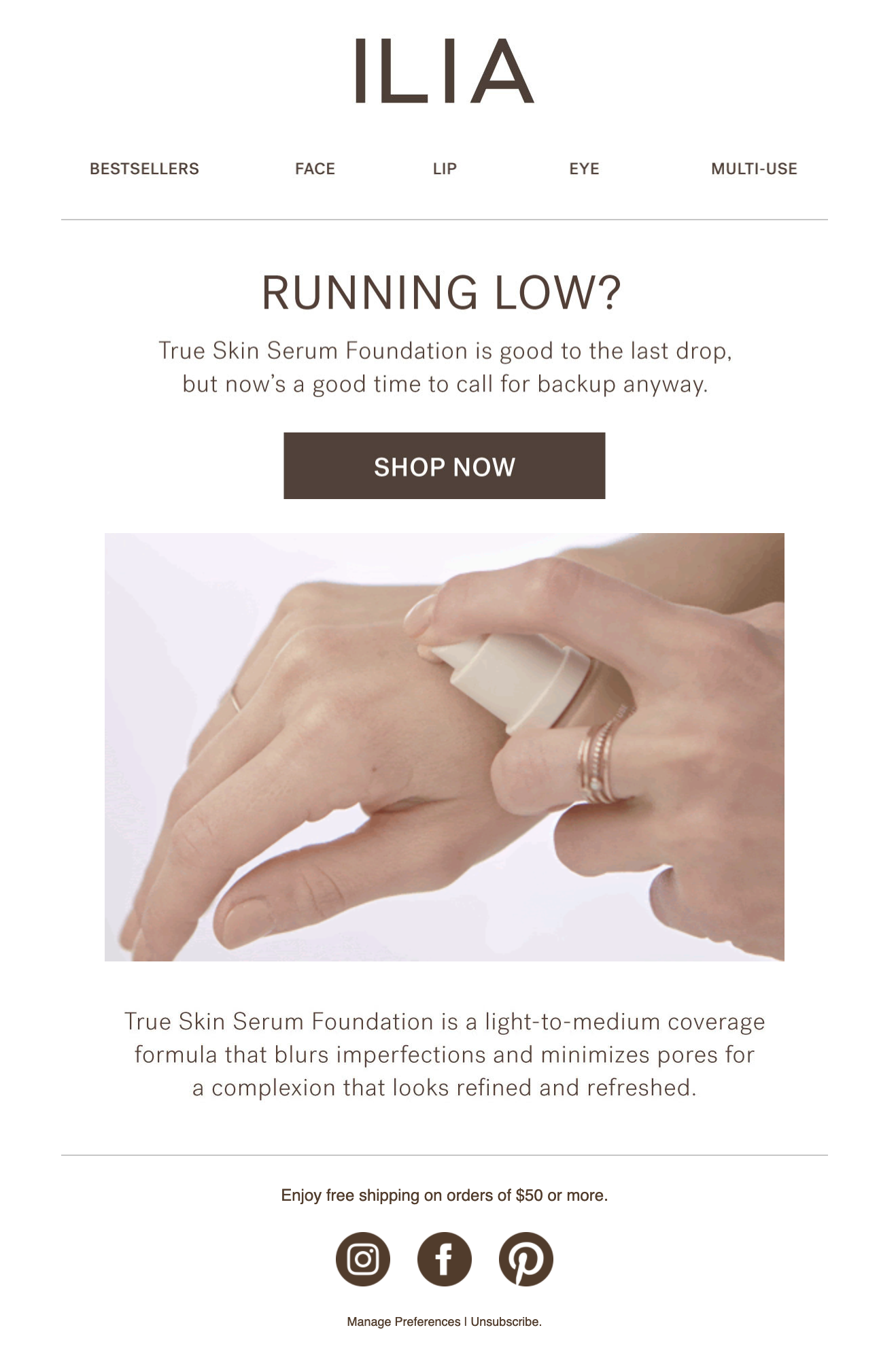
26. Briogeo
Briogeo sends a product replenishment email a few days earlier with “free” offers and it’s a smart move for two reasons:
First, it makes customers feel like Briogeo is looking out for them. Even if they didn’t need to restock on their favorite shampoo, this email makes them feel like the brand is looking out for them and making sure they never run out of products again. This feeling of care builds loyalty among customers and helps build trust in the brand.
Second, the vibrant imagery and animated GIF immediately capture the reader’s attention. The email copy is also extremely relatable to customers.
Finally, Briogeo manages to use the bottom of its replenishment email for product recommendations—which is a great move to entice customers to purchase more products through an upsell or cross-sell option. In case they don’t need to restock on the product they originally bought, there are plenty of other options to try their hand at.

26. Magic Spoon
Magic Spoon’s replenishment email is a fun, light-hearted way to get customers to come back to the site and make another purchase.
The brand understands its customers’ pain, and its replenishment email perfectly brings out this feeling with its messaging: “Don’t settle for smaller bowls just to savor those sweet spoonfuls. Restock your supply and fill those bowls to the top!”
Moreover, the email follows a very easy-going flow making it easy for the customer to spot the CTA and make their way back to Magic Spoon’s website for their next purchase.
Coupled with a fun, bright, and funky design, this completely on-brand and quirky email is a fun read.
27. Ultimate Nutrition
Ultimate Nutrition’s replenishment email is a great example of how to use language together with imagery to get customers to take action.
Notice that the best replenishment campaigns are sent just before the product runs out, so the customer knows there’s urgency involved. With a simple click of a button, the customer can replenish their supply with very little effort.
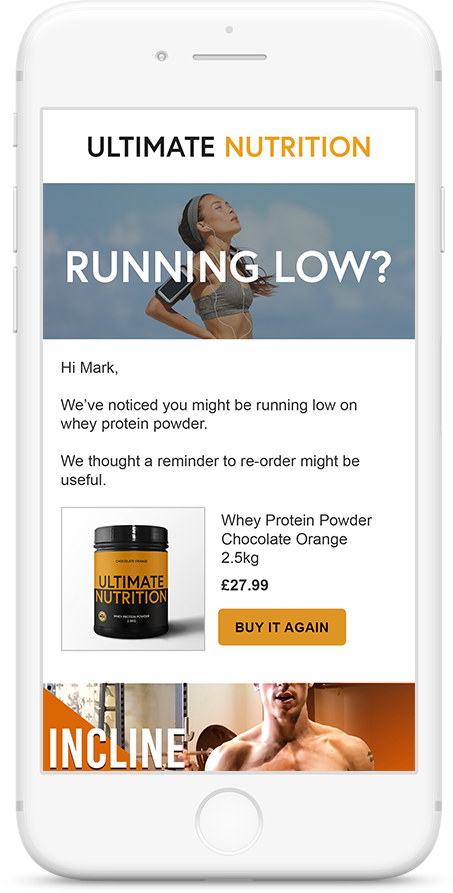
28. PetShopBoy
The template that PetShopBoy uses is simple and straightforward. The font is easy to read, and the images are not distracting.
However, one improvement that could be made would be to change the image of the dog into something more relevant to what the customer ordered.
For example, if a customer purchased a toy for their dog, then an image of a dog playing with one of these toys could be used as opposed to an image of a dog in general.
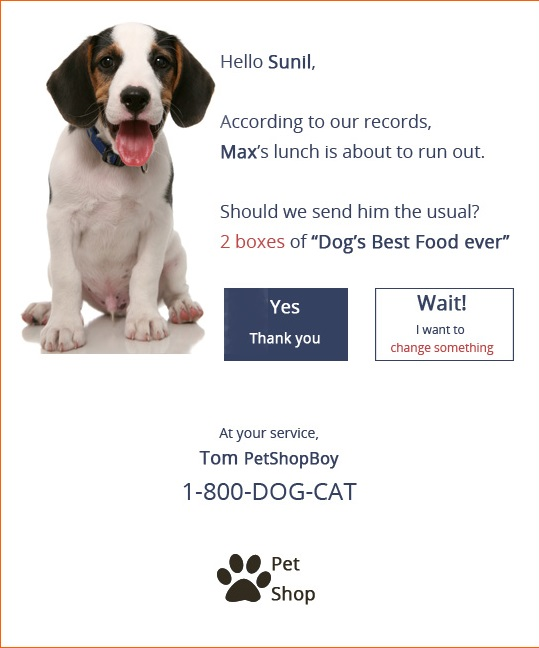
29. JAC Vapour
JAC Vapour has a very specific brand voice—cool, nonchalant, and whimsical. They’re able to capture that personality in just a few sentences, which is no mean feat. Take a look at this email: there isn’t too much copy, just a couple of questions that have been worded in a polite but unstuffy, chilled-out way. This is a useful template for brands that have a wide customer base, made up of men and women of different ages.
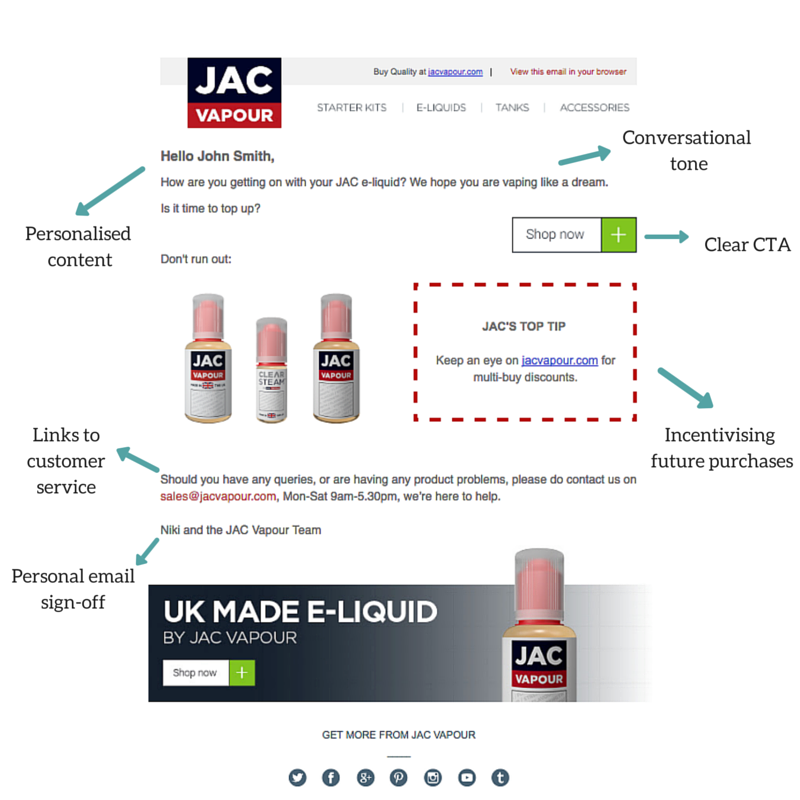
Does your brand need a replenishment email strategy?
So, does your brand need a replenishment email strategy?
The answer is yes.
When it comes to the e-commerce industry, one of the most important aspects is customer retention. If you want to keep your customers coming back for more, then you need to have a replenishment email strategy.
Receiving a reminder email to buy more of your product is one way to encourage customers to buy again and again. This can be particularly useful if you’ve been in business for some time and are trying to expand your customer base by attracting new customers who may have never heard of you before.
It also helps establish loyalty with existing customers, who will appreciate being reminded of something they love and will likely keep coming back for more—again and again!
RetainIQ’s replenishment email flow helps you automate the whole process and free you from the hassles of manually sending replenishment emails.
Eager to explore? Book a demo today



